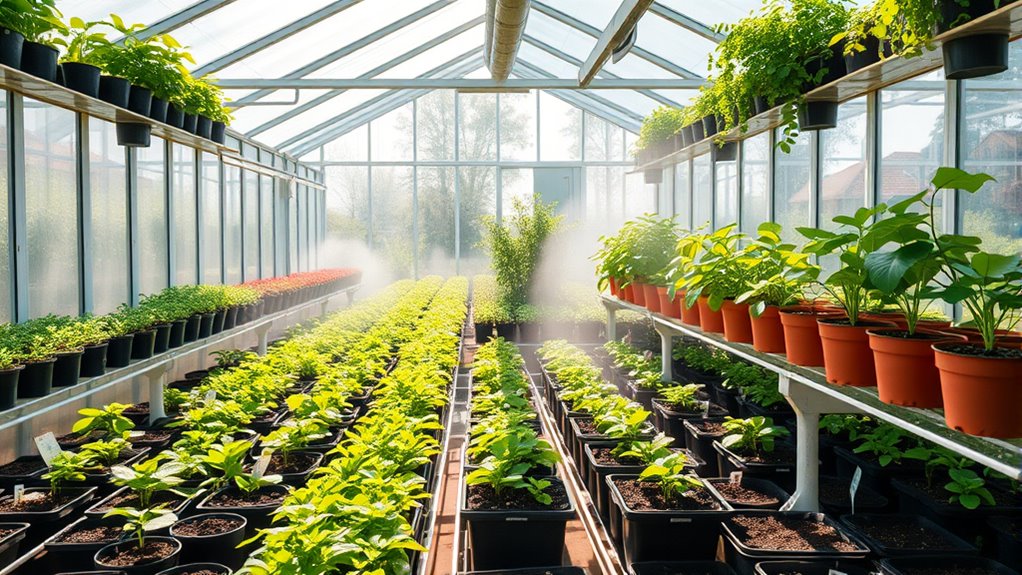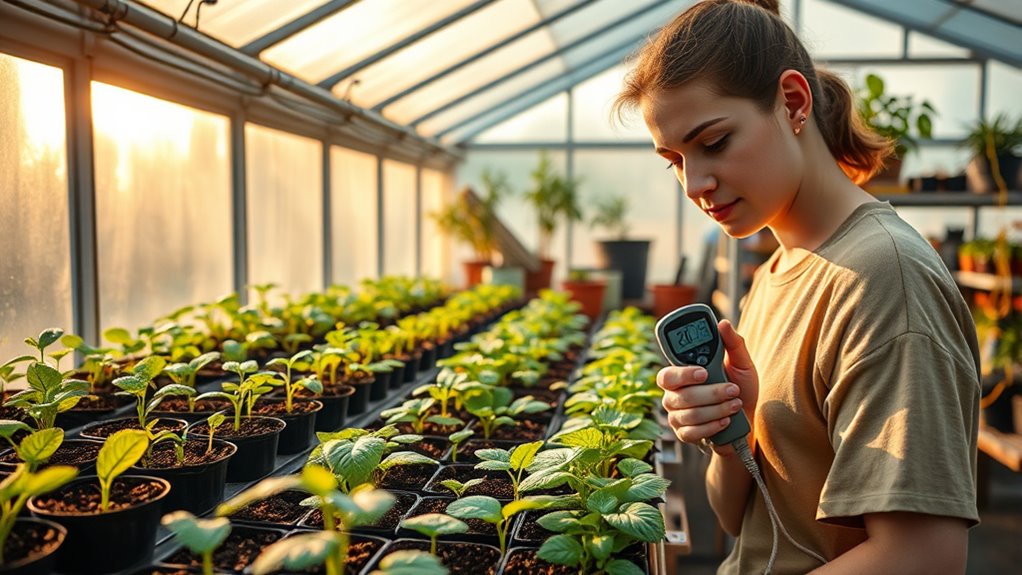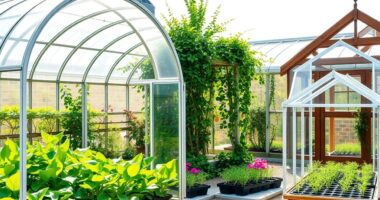To avoid common mistakes as a first-time greenhouse gardener, focus on proper soil preparation and pest management from the start. Test your soil’s pH and add organic matter to create a healthy foundation for your plants. Regularly inspect for pests and use natural controls early. Building strong soil and pest routines now helps prevent problems later, making your greenhouse more successful. Keep these basics in mind, and you’ll set yourself up for a thriving garden.
Key Takeaways
- Test and amend soil pH and nutrients before planting to ensure a healthy foundation.
- Regularly inspect for pests and use natural controls early to prevent infestations.
- Incorporate organic matter and ensure proper drainage to avoid root diseases.
- Avoid rushing soil prep and pest management to establish strong, resilient plants.
- Maintain consistent watering and good air circulation to support plant health and pest resistance.

Starting your first greenhouse can be exciting, but it’s easy to make mistakes that hinder your success. One of the most critical areas to focus on is soil preparation. If you neglect this step, you risk poor plant growth, disease, and pest problems down the line. Before planting, take the time to test your soil’s pH and nutrient levels. Most vegetables and herbs thrive in well-draining soil with a pH between 6.0 and 7.0. If your soil is too acidic or alkaline, amend it accordingly using lime or sulfur. Incorporate organic matter like compost or aged manure to improve soil fertility and structure. Proper soil preparation creates a strong foundation for healthy plant development and reduces the likelihood of root diseases caused by poor drainage or nutrient deficiencies.
Another common mistake is overlooking pest management from the start. A failure to monitor and control pests early can lead to infestations that are tough to manage later. Regularly inspecting your plants for signs of pests such as aphids, whiteflies, or spider mites is essential. Use natural pest control methods whenever possible, such as introducing beneficial insects like ladybugs or using neem oil. Keep your greenhouse clean and remove any dead or diseased plant material promptly, as these can harbor pests and pathogens. Installing physical barriers like insect screens over vents and openings can also help keep pests out. Remember, prevention is always easier and more effective than trying to eliminate pests once they’ve become a serious problem.
It’s also important to understand that soil preparation and pest management are interconnected. Healthy, well-prepared soil produces vigorous plants that are better equipped to resist pests and diseases. Conversely, unhealthy soil can weaken plants, making them more susceptible to infestations. Proper watering practices, avoiding overwatering, and ensuring good air circulation are additional steps that support pest management efforts. When you start your greenhouse, don’t rush through these foundational steps. Investing time and effort into preparing your soil and establishing a pest management routine sets the stage for a successful growing season.
Frequently Asked Questions
How Do I Choose the Best Greenhouse Location?
When choosing the best greenhouse location, you need to consider airflow management and sun exposure. Pick a spot with good airflow to prevent humidity buildup, and make certain it gets ample sunlight for plant growth. Use shade cloths if needed to regulate temperature and protect plants from intense sun. Position your greenhouse where it’s sheltered from strong winds, allowing for better airflow and temperature control, which promotes healthier plants and easier maintenance.
What Are the Signs of Overwatering Plants?
Ever wonder if you’re overwatering your plants? Signs of overwatering include yellowing leaves, wilting despite moist soil, and root rot. You might notice persistent soil moisture that doesn’t dry out between watering sessions. Watering issues often stem from keeping soil too wet, which can suffocate roots and cause problems. To prevent this, check soil moisture regularly and only water when the top inch feels dry.
How Often Should I Air Out My Greenhouse?
You should air out your greenhouse daily to maintain ideal conditions. Use effective ventilation strategies, like opening vents or doors, to promote fresh air flow. Incorporate air circulation techniques such as fans to prevent humidity buildup and reduce disease risk. Regular airing keeps temperatures consistent and improves plant health. Adjust frequency based on weather; on hot or humid days, more frequent airing helps maintain a healthy environment for your plants.
What Pests Are Common in Greenhouses?
In your greenhouse, common pests include aphids, whiteflies, spider mites, and fungus gnats. To prevent these pests, practice pest prevention measures like regular inspection and maintaining cleanliness. Use integrated pest management strategies, combining biological controls, proper watering, and natural predators to keep pests in check. By staying vigilant and proactive, you can protect your plants effectively and reduce the need for chemical treatments.
How Do I Adjust Temperature During Seasonal Changes?
You should regularly monitor your greenhouse temperature using a reliable thermometer. During seasonal changes, adjust ventilation strategies like opening vents or installing exhaust fans to regulate airflow and prevent overheating or cold drafts. Keep an eye on temperature fluctuations and fine-tune your ventilation accordingly. Proper temperature monitoring helps you maintain ideal conditions for your plants, ensuring they thrive despite seasonal shifts.
Conclusion
Starting your greenhouse garden can be rewarding, but avoid common mistakes to guarantee success. Remember, over 70% of new gardeners report increased yields when they follow proper practices. Stay attentive to your plants’ needs, monitor environmental conditions, and don’t rush the process. With patience and care, you’ll enjoy a thriving greenhouse. Keep learning and adjusting as you go—your green thumb will grow stronger with each mistake you circumvent!









